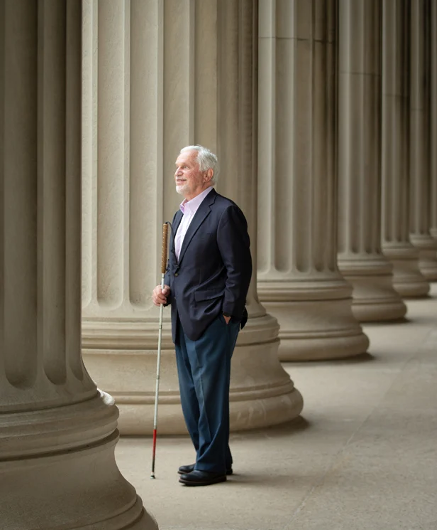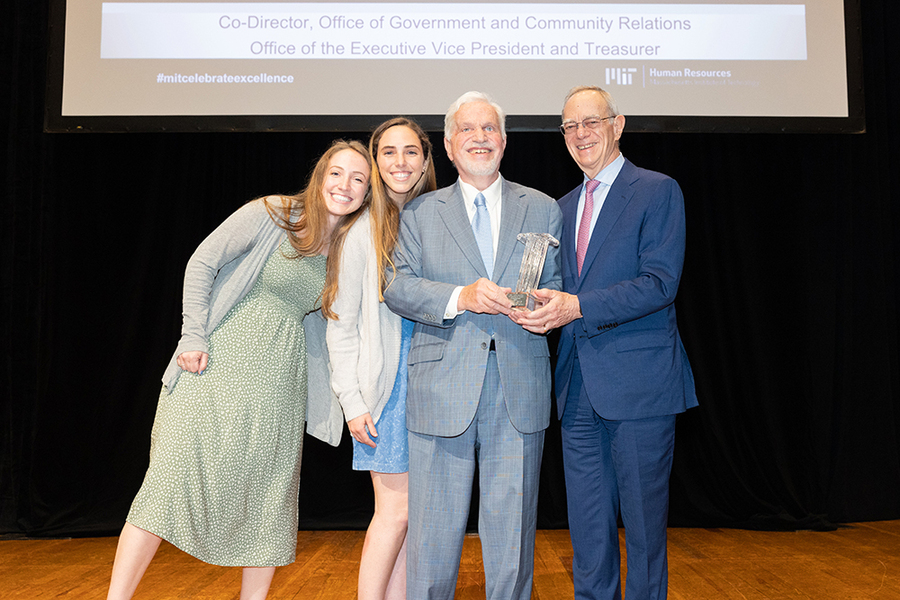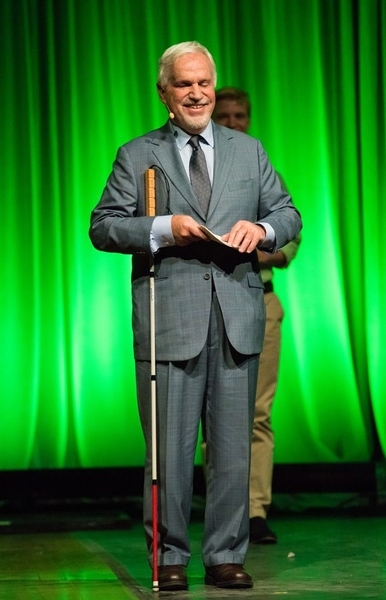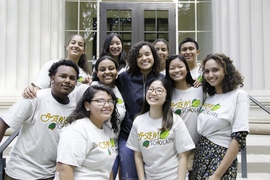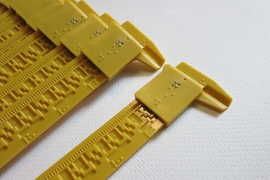Paul Parravano, who worked for 33 years to build enduring MIT connections with elected officials and the local community, died at his home in Arlington, Massachusetts, on Dec. 9.
Parravano, who was 71, was diagnosed with pancreatic cancer shortly after retiring in January from his full-time work as co-director of MIT’s Office of Government and Community Relations — a role that earned him a reference last year as the “Mayor of MIT.”
“‘So, tell me about yourself’ was an invitation Paul would work into every conversation he had,” says Sarah Eusden Gallop, who served alongside Parravano as co-director for more than 25 years. “Perhaps he might discover a mutual love of soccer, a Michigan connection, a passion for Italian food, a similar taste in music, or simply a shared joy in being a parent. Paul was masterful in his desire and ability to make connections with people. It was his job to do so, after all. But he came at it naturally, with a deep authenticity.”
The son of Italian immigrants, Parravano grew up in Ann Arbor, Michigan, where his father was a professor of chemical engineering at the University of Michigan. He went on to earn a bachelor’s degree in political science and government from Harvard University and a law degree from Northeastern University. Before joining MIT, he worked for several organizations in support of special education and civil rights, utilizing his legal training to assist in navigating federal regulations.
Parravano joined MIT in 1990 as assistant for government and community relations, joining Gallop in 1997 as co-directors of what is now the Office of Government and Community Relations. During his 33 years at MIT, he served as a liaison between the Institute and all levels of government and the local community in an effort to foster communication and understanding.
“Everyone who knew Paul also knew that his approach to being a ‘liaison’ was uniquely his own,” says Gallop, who continues as MIT’s director of government and community relations.
At MIT, Parravano worked closely with public officials, advocacy groups, and nonprofit organizations at the local, state, and national levels. On behalf of three MIT presidents, he established and participated in regular visits with government leaders in Washington to help advance the cause of science and research. He arranged countless campus visits for dignitaries, community leaders, and schoolchildren.
“Somehow, he seemed to know everyone, and everyone everywhere knew him,” President Emeritus L. Rafael Reif says. “Paul would arrange the itineraries of our Washington, D.C., trips with tremendous preparation. We would meet with members of Congress or the administration to discuss federal policy positions impacting science and technology research and higher education, and everywhere we went people would greet Paul warmly. I have so many wonderful memories of our visits, filled with moments of great seriousness about national issues, shared delight in MIT’s accomplishments, and beautiful personal interactions. I will always remember the sight of him walking down the Infinite Corridor, whistling some Italian tune, as it always lifted my spirits.”
Parravano was a strong advocate for research and education at the national level — and was also committed to providing access to science, technology, engineering, and math for young Cambridge learners. At MIT, he was fully comfortable in the world of science, and would often team up with classes to explore advancements in assistive technology and health care.
“For over 20 years, Paul would come to our classroom and share his life and experiences influenced by retinal cancer, which caused him to lose his sight before the age of 2,” says David Housman, professor of biology. “His passion and openness created a crucial experience for students destined to be caregivers as physicians and pioneers in medical research. Paul taught them in a memorable way the importance of understanding the medical challenges they would face from a human point of view. My students recall decades later the impact Paul has had on them as they try to make a positive difference in the world.”
Unimpeded by physical barriers, Parravano diligently sought to improve his life and the lives of others by helping make the world more accessible for those with disabilities. A longtime board member of National Braille Press, he advocated for the greater use of Braille in public spaces and on everything from restaurant menus to voting booths to utility bills. He became an expert at finding ways to modify and use newer technologies.
On campus, Parravano also supported participation in voting and elections, served as secretary for MIT’s Community Service Fund, acted as an advocate and a research participant in the field of assistive technology, and was a longtime committee member (and chair) of the Institute’s annual MLK Jr. Celebration.
“Paul was a staple within the MLK Celebration Committee and was always loved and respected for all that he did here at MIT and in the Cambridge community,” says former MIT staff member Zina Queen, who served as co-chair of MIT’s Martin Luther King Jr. Celebration Committee.
In Cambridge, Parravano attended thousands of community events, proudly served on many nonprofit boards, promoted support for local agencies through MIT’s Community Service Fund, reveled in frequenting local restaurants, and was a regular on the No. 1 bus between MIT and Harvard. His knowledge of the City of Cambridge, and the greater Boston region, impressed many, and his keen interest was always in trying to help others.
“Paul had a great fealty to MIT, but was imbued with the love of Cambridge,” former Mayor Kenneth E. Reeves says. “He knew that it was a complicated relationship, but he could walk the tightrope between the two and represent the best of both with honor and integrity. He held a very special place in the hearts of the citizens in Cambridge. I think he will forever be there. He’s in the DNA of the city now.”
From delivering pastries to election workers at MIT’s polling location to gifting his beloved Michigan-based Sayklly’s chocolates to colleagues during the holidays, Parravano had an uncanny ability to recognize voices, which was helpful to him as a blind individual. He hardly ever had to wait for people to say their names; he knew who they were and quickly greeted them with a personal reflection or a humorous observation. He made everyone feel good, Gallop says.
“Paul wove deep connections between MIT and the larger world it exists to serve, driven by his belief in this institution’s mission and abilities,” adds Executive Vice President and Treasurer Glen Shor. “We long enjoyed his good cheer and were inspired by his personal resilience. He leaves a lasting legacy of positive impact.”
For his work in supporting the Cambridge community, Parravano received many awards in gratitude for his advocacy, including the Cambridge NAACP’s Lifetime Achievement Award and the Cambridge Community Center’s Reverend E.K. Nichols Founder’s Award.
In June 2022, Parravano became the inaugural recipient of the MIT Staff Award for Distinction in Service. At the award ceremony, former president Reif referred to Parravano as the “Mayor of MIT.”
Parravano is survived by his wife, Martha, and by his daughters Emily and Ellie, whom he referred to as the greatest gifts in his life. He is also survived by three brothers and a large extended family of nieces, nephews, and cousins both in the U.S. and Italy.
A memorial gathering will be held at MIT in early spring 2024. The Parravano family has established the Paul Parravano Memorial Fund at MIT in support of student research in the field of assistive technology.
